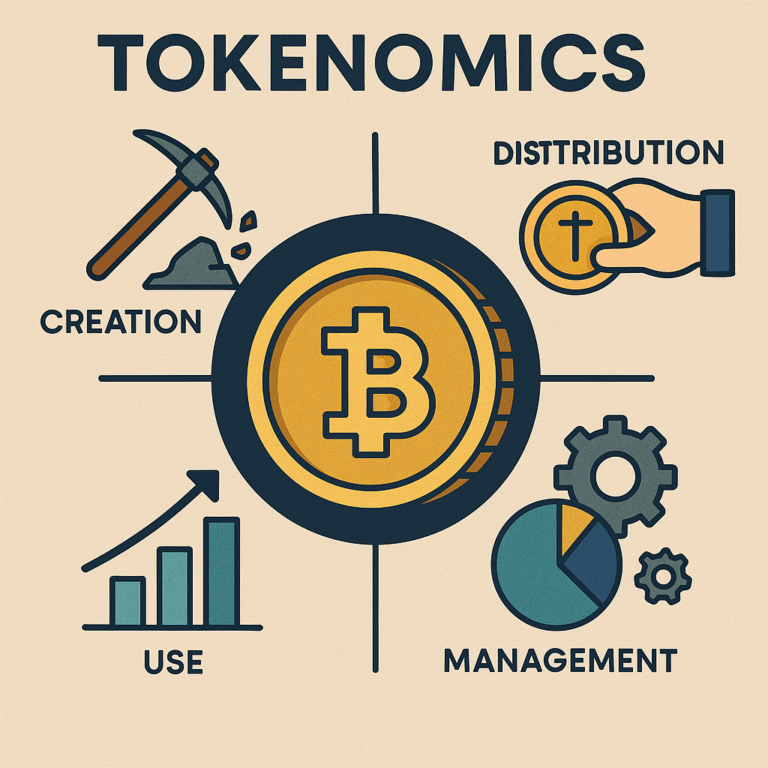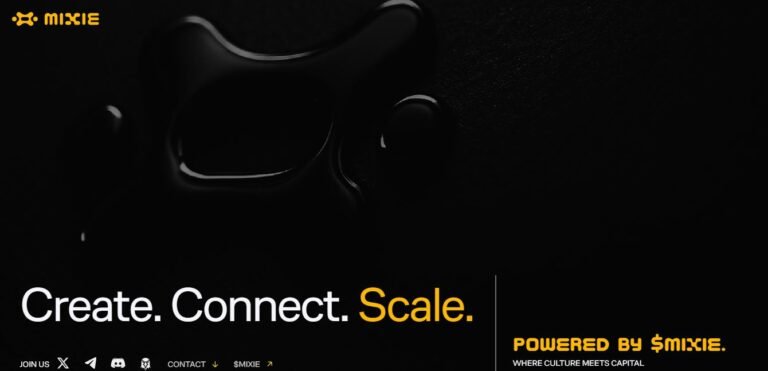Stablecoin Tokenomics: How Pegs, Collateral, and Algorithms Work
1. What Are Stablecoins and Why They Matter
Stablecoin Tokenomics: Stablecoins are a class of cryptocurrencies designed to maintain a stable value, typically pegged to a fiat currency like the US Dollar, Euro, or even commodities like gold. Unlike traditional cryptocurrencies such as Bitcoin or Ethereum, which are highly volatile, stablecoins aim to offer price consistency — making them useful for trading, saving, lending, and payments.

In the world of DeFi, stablecoins play a critical role by offering a bridge between the crypto economy and traditional financial systems. They are widely used in yield farming, cross-border transactions, remittances, and as collateral in decentralized applications (dApps).
The Role of Tokenomics in Stability and Trust
What makes a stablecoin “stable”? The answer lies in tokenomics — the economic rules that define how the stablecoin is created, maintained, and governed. Tokenomics encompasses:
- Pegging mechanisms (how the price is stabilized)
- Collateral models (what backs the stablecoin)
- Minting and burning logic
- Incentives for users and arbitrageurs
- Governance structures (centralized vs decentralized)
Without a strong tokenomic foundation, even the most well-marketed stablecoins can collapse — as seen in the case of TerraUSD (UST).
Types of Pegs: USD, Euro, Gold, Crypto
Stablecoins can be pegged to various assets depending on their use case and target market:
- USD Peg: Most common (e.g., USDT, USDC, DAI)
- Euro Peg: Popular in European markets (e.g., EURS)
- Gold Peg: Used for commodity-backed stability (e.g., PAXG)
- Crypto Peg: Pegged to another digital asset or basket (e.g., sBTC, MIM)
Each peg type requires different tokenomic strategies to maintain trust and price stability.
2. The Core Mechanism: Understanding the Peg
What Is a Peg in Crypto?
In crypto, a peg refers to a stablecoin’s price being tied to the value of a specific asset — typically $1 USD, but it can also be pegged to other fiat currencies, commodities, or even crypto assets. The goal of a peg is to ensure that 1 stablecoin always equals 1 unit of the reference asset (e.g., 1 USDC = $1).
📌 The challenge: crypto markets are volatile and decentralized — so maintaining that 1:1 peg requires robust tokenomic mechanisms.
Hard Peg vs. Soft Peg Explained
- Hard Peg: The stablecoin maintains a strict 1:1 value by backing every token with reserves. Example: USDC, USDT.
- Soft Peg: The stablecoin’s value fluctuates slightly around the target price and relies on algorithms, incentives, or collateral ratios to bring the price back to peg. Example: DAI, FRAX.
| Type | Backing | Example | Stability Tool |
| Hard Peg | Fully reserved | USDC, BUSD | Real fiat reserves |
| Soft Peg | Overcollateralized or algorithmic | DAI, FRAX | Algorithms, collateral liquidation, arbitrage |
Why Maintaining a Peg Is Crucial
If a stablecoin breaks its peg, trust is lost — and often, so is value. Here’s what can happen:
- Loss of confidence → users sell off the stablecoin
- Market crashes in DeFi protocols that rely on the stablecoin
- Liquidations and debt spiral if used as collateral (e.g., in MakerDAO)
- Regulatory scrutiny if seen as unstable or misleading
In short, maintaining the peg is everything — and tokenomics is the engine that makes it possible.
3. Types of Stablecoins: How They Maintain Their Value
Stablecoins use different models to maintain their peg. Each comes with its own tokenomic strategy, level of decentralization, risk profile, and degree of trust. Let’s break them down:
3.1 Fiat-Collateralized Stablecoins
These stablecoins are backed 1:1 by real fiat currency held in reserves, typically in banks or trusted custodians.
✅ Examples: USDT (Tether), USDC (Circle), BUSD
🔧 How It Works:
- For every 1 stablecoin issued, $1 is held in reserve.
- Users can redeem the stablecoin for fiat, helping maintain the peg.
- Some issuers undergo audits or attestations to prove solvency.
📈 Pros:
- High price stability
- Easy to understand
- Widely accepted across exchanges
⚠️ Cons:
- Centralized control and custody
- Regulatory risk and lack of full transparency (e.g., Tether controversies)
3.2 Crypto-Collateralized Stablecoins
These are backed by other cryptocurrencies, often with overcollateralization to account for crypto’s price volatility.
✅ Examples: DAI (by MakerDAO), LUSD (by Liquity)
🔧 How It Works:
- Users lock up crypto (like ETH) in smart contracts.
- A smaller amount of stablecoin is minted (e.g., $150 ETH = $100 DAI).
- If the collateral value drops, the position may be liquidated to preserve the peg.
📈 Pros:
- Decentralized and transparent
- No need for fiat banks
⚠️ Cons:
- Complex for beginners
- Requires overcollateralization
- Can be vulnerable during market crashes (e.g., Black Thursday 2020)
3.3 Algorithmic Stablecoins
These stablecoins use algorithms and smart contracts to control supply and demand rather than rely on collateral.
✅ Examples: FRAX (hybrid), Ampleforth, (former) UST
🔧 How It Works:
- When price > $1 → mint more tokens to lower the price.
- When price < $1 → burn/reduce supply to raise the price.
- Some models introduce seigniorage shares or bond tokens to balance demand.
📈 Pros:
- Capital efficient (no need for collateral)
- Scalable and innovative
⚠️ Cons:
- High failure rate
- Fragile peg maintenance
- UST/LUNA collapse is a cautionary tale
4. Key Tokenomics Principles in Stablecoins
To maintain a stable peg, stablecoins rely on well-designed tokenomics — the mechanisms that govern supply, demand, trust, and incentives. Let’s explore the core components:
🔐 4.1 Collateralization Ratio
- This is the ratio between the value of collateral and the issued stablecoins.
- Fiat-backed: Typically 1:1 (100%)
- Crypto-backed: Often 150% or more (e.g., deposit $150 ETH to mint $100 DAI)
- Algorithmic: May use partial collateral or none at all (FRAX starts at ~80%)
🧠 Why it matters: Higher collateral ratios = more safety, but less capital efficiency.
🔥 4.2 Mint and Burn Mechanisms
- Minting: New tokens are created when users deposit collateral or demand rises.
- Burning: Tokens are destroyed when users redeem them or supply needs to be reduced.
Example:
- USDC mints when users deposit USD.
- DAI is minted via Maker Vaults and burned on repayment.
- FRAX burns/mints to maintain price via arbitrage incentives.
💰 4.3 Incentives and Stability Fees
- Some stablecoins charge fees for minting/borrowing (e.g., DAI’s “Stability Fee”).
- Others pay interest to holders or provide yield (e.g., staking rewards or rebasing gains).
- Some use arbitrage opportunities (buy low, sell high) to encourage peg stability.
⚖️ Balance is key: Too little incentive, and users won’t engage. Too much, and it’s unsustainable.
🏛️ 4.4 Governance and Treasury Management
- Decentralized stablecoins (e.g., MakerDAO, FRAX) are governed by token holders.
- These protocols manage treasuries, collateral types, and risk parameters.
- Decisions include:
- Changing collateral ratios
- Onboarding new collateral
- Adjusting stability fees or rewards
Governance can adapt tokenomics to market conditions, helping maintain long-term stability.
🌐 4.5 Oracles and Real-Time Pricing
- Accurate, real-time price feeds are essential to trigger minting, liquidation, or rebalancing.
- Trusted oracle networks (like Chainlink) provide off-chain pricing data to smart contracts.
❗ Oracle failure = peg failure. Tokenomics depend heavily on oracle reliability.
5. Case Studies: Successes and Failures of Stablecoin Models
By analyzing real-world stablecoins, we can see how tokenomics perform under pressure. These case studies reveal the strengths, weaknesses, and lessons behind different stablecoin designs.
🟢 5.1 USDC — Regulated and Reserve-Backed
Type: Fiat-Collateralized
Peg Mechanism: $1 USD in reserves per USDC
Issuer: Circle (regulated U.S. company)
Why It Works:
- Fully backed by audited fiat reserves
- Regulated and transparent
- Widely trusted by institutions
Tokenomics Highlights:
- 1:1 redemption model keeps peg strong
- Simple and centralized — low risk, high stability
- Monthly attestations published publicly
✅ Lesson: Trust, transparency, and regulation can be just as important as code.
🟡 5.2 DAI — Decentralized but Complex
Type: Crypto-Collateralized
Peg Mechanism: Overcollateralized loans (e.g., ETH, USDC)
Issuer: MakerDAO (decentralized governance)
Why It Works:
- Maintained peg for years despite crypto volatility
- Backed by a mix of volatile and stable collateral
- Governed by MKR token holders
Tokenomics Highlights:
- Uses stability fees, collateral auctions, and liquidation penalties
- Highly flexible — can adapt to market risks
- Introduced real-world assets to diversify reserves
⚖️ Lesson: DAI’s success shows that decentralized, on-chain tokenomics can work — but require strong governance and complexity.
🔴 5.3 UST (Terra) — A Failed Algorithmic Model
Type: Algorithmic
Peg Mechanism: Burn/mint relationship with LUNA
Issuer: Terra Labs
What Went Wrong:
- Peg failed in May 2022, leading to a $40B collapse
- As UST depegged, users lost confidence
- LUNA hyperinflated as minting tried to restore peg
Tokenomics Failure Points:
- No collateral backing (zero safety net)
- Feedback loop led to a “death spiral”
- Peg relied too heavily on market faith and algorithmic incentives
🚨 Lesson: Algorithmic stablecoins without collateral are extremely fragile in high-stress markets.
🟠 5.4 FRAX — A Hybrid Approach That Adapts
Type: Hybrid (Partially Collateralized + Algorithmic)
Peg Mechanism: Dynamic collateral ratio + market incentives
Issuer: Frax Finance
Why It’s Innovative:
- Starts with partial collateral, reduces over time based on demand
- Uses Curve pools, staking, and protocol-owned liquidity
- FRAX also launched its own decentralized stable assets and lending protocol
Tokenomics Highlights:
- Flexible peg maintenance through arbitrage
- Governance adjusts collateral ratio algorithmically
- Market-proven resilience, but still not risk-free
🔄 Lesson: Hybrid models like FRAX show that combining collateral with algorithms can offer a more resilient solution.
6. Challenges and Risks in Stablecoin Tokenomics
Even the most well-designed stablecoin tokenomics face real-world threats. Understanding these risks is key to building and investing in stablecoins that can stand the test of time.
🌀 6.1 Black Swan Events and Peg Breaks
- Extreme market crashes, like the 2020 COVID crash or the 2022 Luna collapse, can destroy even overcollateralized systems.
- Liquidity dries up, panic spreads, and the peg can break despite good design.
- Example: DAI temporarily depegged during “Black Thursday” in 2020.
⚠️ Lesson: Resilience in tokenomics must account for extreme market conditions, not just average days.
🛑 6.2 Regulatory Uncertainty
- Governments are increasingly focused on regulating stablecoins.
- Fiat-backed stablecoins may be forced to comply with banking regulations, KYC/AML, and full reserve audits.
- Decentralized or algorithmic models may be banned, blacklisted, or restricted.
🧾 Impact: Compliance requirements may limit how “open” stablecoins can truly be — affecting adoption and design.
🧠 6.3 Smart Contract and Oracle Risks
- Stablecoins depend on smart contracts and oracles to manage minting, burning, and price tracking.
- Bugs or exploits can lead to loss of funds, price errors, or peg failures.
- Oracle manipulation has caused millions in losses across DeFi protocols.
🔐 Example: If an oracle misreports the ETH price, it could trigger undercollateralized DAI minting or unwanted liquidations.
💣 6.4 Liquidity Crises and Run Risk
- If too many users try to redeem at once (a “bank run”), the stablecoin can collapse — especially if reserves aren’t liquid.
- Algorithmic models are particularly vulnerable to panic withdrawals, as seen with UST.
🔍 Risk management includes building deep liquidity pools and having circuit breakers or emergency stabilization tools.
♻️ 6.5 Governance Attacks and Protocol Capture
- Stablecoins with decentralized governance (like MakerDAO or Frax) can be vulnerable to:
- Governance token whales
- Vote manipulation
- Poor decision-making
📢 Lesson: Governance decentralization needs to be truly distributed and well-informed, or tokenomics may degrade over time.
7. The Future of Stablecoin Tokenomics
As the crypto space matures and regulation tightens, the future of stablecoin tokenomics is rapidly evolving. Here’s what lies ahead:
🚀 7.1 Rise of Hybrid Models
- Projects like Frax and Ethena are pioneering dynamic tokenomics that blend collateral and algorithmic mechanisms.
- Expect more programmable, flexible stablecoins that can adapt in real time to market volatility.
🔄 Trend: Smart contracts will adjust collateral ratios, fees, and minting rules algorithmically — like adaptive monetary policy.
📊 7.2 On-Chain Transparency and Audits
- Real-time proof-of-reserve systems (e.g. Chainlink’s PoR) will become standard for fiat-backed stablecoins.
- Users will demand auditable, transparent collateral systems — not just promises.
👁️🗨️ Example: Circle (USDC) publishes monthly attestations; future leaders may publish live dashboards.
🌍 7.3 Real-World Asset (RWA) Backed Stablecoins
- More stablecoins will be backed by tokenized assets like government bonds, real estate, or carbon credits.
- Protocols like MakerDAO and Ondo Finance are already integrating RWAs for more sustainable yield and stability.
🏛️ Shift: Tokenomics will start to mirror traditional finance (TradFi), while maintaining DeFi efficiency.
⚖️ 7.4 Regulation-Ready Design
- Future tokenomics will be built with compliance in mind, especially in major economies (US, EU, Asia).
- Expect emergence of central bank-compliant stablecoins or hybrid public-private models (e.g., PayPal USD, MiCA-ready coins).
🔐 Stablecoins that balance privacy, security, and regulation will lead global adoption.
🌐 7.5 Cross-Chain and Modular Stablecoins
- Next-gen stablecoins will be interoperable across blockchains, using modular tokenomics for different environments.
- Protocols will build multi-chain liquidity pools, cross-chain minting, and omnichain collateral systems.
🔄 Example: LayerZero and Cosmos IBC-compatible stablecoins.
🔚 Final Thoughts
Stablecoin tokenomics is no longer just about holding a $1 peg — it’s about resilience, innovation, transparency, and trust. The best designs blend economics, technology, and governance into systems that can survive any market cycle.




